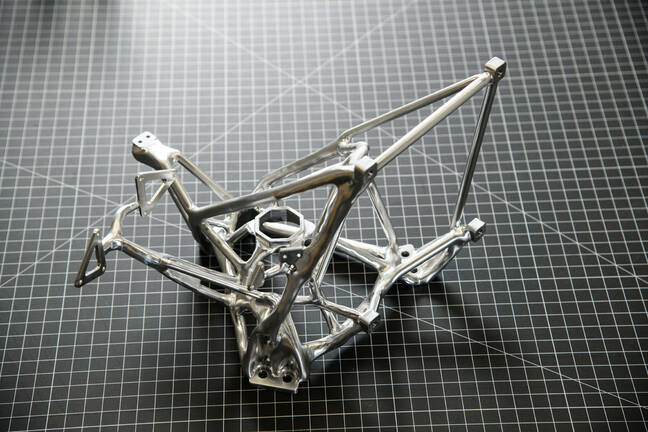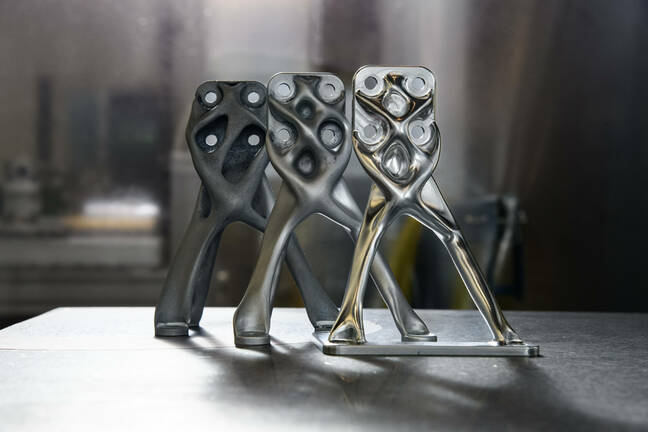This article is more than 1 year old
Language, schmanguage: NASA's generative AI builds spaceships
Or their parts, at least, which look decidedly skeletal for satellite struts
When NASA's balloon-borne exoplanet-observing telescope EXoplanet Climate Infrared TElescope (EXCITE) takes to the skies this fall it'll be doing so with a scaffold and support struts with a unique feature: they were designed by an artificial intelligence algorithm.
Using a method dubbed "evolved structures," NASA Goddard Space Flight Center research engineer Ryan McClelland's design said the aim was to reduce the mass of spacecraft structural components by two thirds, while at the same time reducing stress risks, by using commercially-available AI software to build parts that can be machined by commercial vendors.
"They look somewhat alien and weird, but once you see them in function, it really makes sense," McClelland said.

An evolved structure designed for NASA's EXCITE mission using AI
If not alien, the parts could also be described as looking biological in design, like bones or structures that would have evolved to suit the needs of whatever naturally-occurring spacecraft might have evolved on other worlds, if science fiction is to be believed.
That makes sense given the design process, as NASA explains it. Using CAD software, an engineer tells the system what the part needs to do, how it'll attach to other parts, defines dead spaces where material can't be placed and the AI system generates a part from there.
McClelland said it's a huge departure from the old days when that process could take considerable time. "You can perform the design, analysis and fabrication of a prototype part, and have it in hand in as little as one week," McClelland said of the advanced method.
That said, there is a computer doing the designing independently, and we know AI doesn't always do the best job with the information it's given. McClelland said that's the case here too, which is why he said a human reviewer is still fundamental to the evolved structure design process.
"Human intuition knows what looks right, but left to itself, the algorithm can sometimes make structures too thin," McClelland said.
NASA is getting EXCITEd about generative design
McClelland said he started working on his evolved structure method during the COVID-19 pandemic, and has received a couple rounds of research funding for his process.
The design system has already been adopted for several NASA missions that are all still in development and includes "astrophysics balloon observatories, Earth-atmosphere scanners, planetary instruments, space weather monitors, space telescopes, and even the Mars Sample Return mission," NASA said.
- Scientists develop AI algorithms to hunt for cancer-fighting antibodies
- NASA, DARPA to go nuclear in hopes of putting boots on Mars
- Could 2023 be the year SpaceX's Starship finally reaches orbit?
- The CES tat bazaar: Bike desks, AI-powered bird feeders, and the smelloverse
If everything goes to plan, EXCITE will be used to study the atmospheres of hot Jupiter-like planets orbiting other stars. It's designed to perform phase-resolved spectroscopy, which involves continual observations of target stars, and its sensitivity range will help it pick up traces of hydrogen and carbon-containing molecules in exoplanet atmospheres.
NASA Goddard Physicist Peter Nagler, who is leading the EXCITE project, said that there were a couple tricky areas in EXCITE's plans that made trying an AI design sensible.
For example, the struts designed for EXCITE appear to twist, criss-cross and are uneven. Those struts, however, are perfect for resisting off-centered forces that will tug at EXCITE's SUV-sized payload while airborne.

Evolved structure support struts designed for NASA's EXCITE mission
The larger frame for EXCITE includes pathways for laser equipment, as well as space to account for human hands needing to squeeze in and fiddle with the electronics during construction. Nagler said the design requirements for that piece were particularly tricky, as it's designed to attach to a carbon fiber plate - a far different material from the core aluminum structure.
By accounting for all those factors, the scaffold design can be built "to have an interface between [it and the carbon fiber] that won't stress either material," Nagler said, despite "these materials [having] very different thermal expansion properties."
McClelland hopes that his AI approach to design will take off more widely at NASA, which has a particular use case for one-off designs like his.
"If you're a motorcycle or car company there may be only one chassis design that you're going to produce, and then you'll manufacture a bunch of them. Here at NASA, we make thousands of bespoke parts every year," McClelland said.
EXCITE's first long-term flight is planned for 2024, but the team hopes to get it off the ground for an engineering test flight "as early as" this fall. ®
